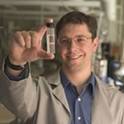
In this paper we report a novel four-step process for the production of jet and diesel fuel range alkanes from hemicellulose extracts derived from northeastern hardwood trees. The extract is representative of a byproduct that could be produced by wood-processing industries such as biomass boilers or pulp mills in the northeastern U.S. The hemicellulose extract tested in this study contained mainly xylose oligomers (21.2 g/l xylose after the acid hydrolysis) as well as 0.31 g/l glucose, 0.91 g/l arabinose, 0.2 g/l lactic acid, 2.39 g/l acetic acid, 0.31 g/l formic acid, and other minor products. The first step in this process is an acid-catalyzed biphasic dehydration to produce furfural in yields up to 87%. The furfural is extracted from the aqueous solution into a tetrahydrofuran (THF) phase which is then fed into an aldol condensation step. The furfural-acetone-furfural (F-Ac-F) dimer is produced in this step by reaction of furfural with acetone in yields up to 96% for the F-Ac-F dimer. The F-Ac-F dimer is then subject to a low-temperature hydrogenation to form the hydrogenated dimer (H-FAF) at 110–130 °C and 800 psig with a 5 wt% Ru/C catalyst. Finally the H-FAF undergoes hydrodeoxygenation to make jet and diesel fuel range alkanes, primarily C13 and C12, in yields up to 91%. The theoretical yield for this process is 0.61 kg of alkane per kg of dry xylose derived from the hemicellulose extract. Experimentally we were able to obtain 76% of the theoretical yield for the overall process. We estimate that jet and diesel fuel range alkanes can be produced from between $2.06/gal to $4.39/gal depending on the feed xylose concentration, the size of the biorefinery, and the overall yield. Sensitivity analysis shows that the prices of raw materials, the organic-to-aqueous mass ratio in the biphasic dehydration, and the feed xylose concentration in the hemicellulose extract significantly affect the product cost.
Available at: http://works.bepress.com/george_huber/22/
